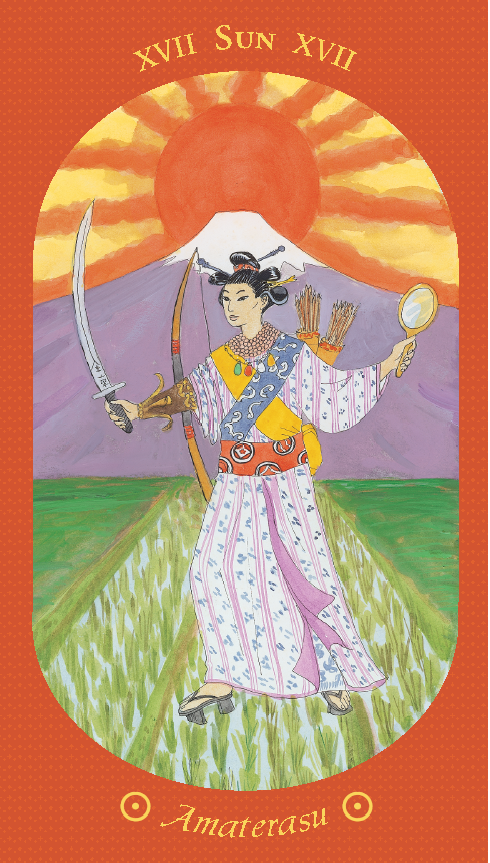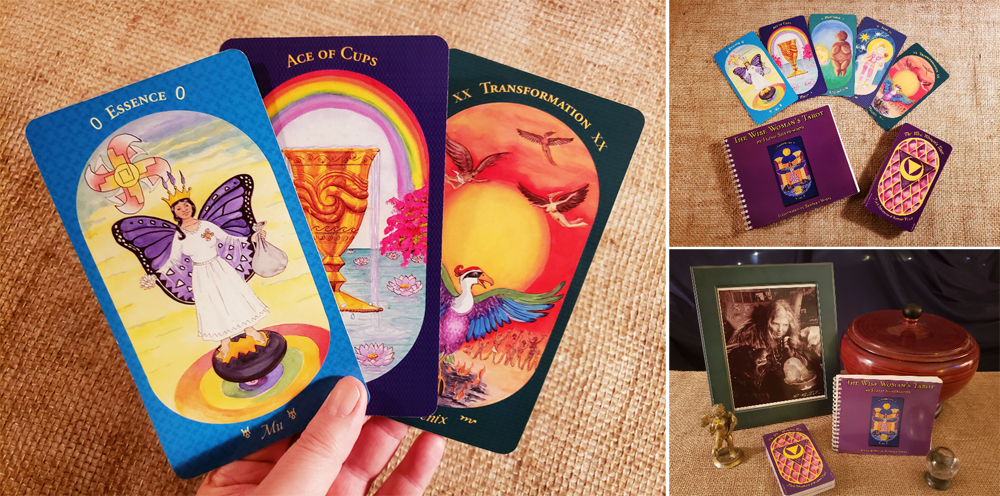
KEYWORDS: Self-expression, joy, well-being.
The Sun represents the radiant globe that illuminates our solar system, as well as the solar, masculine or yang archetype.
For the image of the Sun, I chose Amaterasu, the Japanese Sun Goddess. “Of all the religions currently practiced by significant numbers of people, the only one whose chief deity is female is Japanese Shinto, based on the worship of the Sun-Goddess Amaterasu ,“Great Shining Heaven”. She is worshipped in her simple shrines, notable for their architectural purity and unpretentiousness, and for the central mirror representing the Goddess.” She is regarded as the supreme deity and guardian of the Japanese people. The rising sun, which is her symbol, still adorns the Japanese flag.
Shintoism or “the way of the spirits”, is a religion of contrast, combining a deep reverence for nature and simplicity with a concept of “Divine Right” for the royal line descending from Amaterasu.
If one thinks about it, these diametrically opposed concepts of simplicity and regality are appropriate to the worship of the Sun. The Sun is the most luminous, brilliant, regal heavenly body in our universe, while its function, although essential to life and growth, is simply to shine. The ancient Shinto beliefs are similar in style to Taoist and Native American concepts of Mother Earth.
As Stone observes in Ancient Mirrors: “The one word most important in understanding this perception of the world is kami. Defined as spirit or spiritual essence, it is the acknowledgement of the kami in each manifestation of natural life that endows the perceiver with an understanding of the spiritual dynamics of the world.” This word comes from the Ainu, who were the original inhabitants of Japan.
The elaborately dressed image of Amaterasu is the focal point of this card. Her hair is wrapped in bunches, as was her custom. About her neck are 5 strands of maga tama beads. These Beads, together with her Mirror and her Sword (eight hands long) are the famous “Three Holy Articles.” She holds the Mirror in her left hand; interestingly, the left side is often considered the “honorable” side in this female/solar culture.
Also hanging from Amaterasu’s neck are the four sacred jewels: the Jewel of Life, the Jewel of Resuscitation, the Jewel of Plenty, and the Jewel of Turning Back on the Road. Criss-crossed over her breasts are the Snake- and Bee-Repelling Scarves, while around her waist she drapes another Scarf to Ward Off Various Things.
She is also shown as bearing two quivers of many arrows, the Sword eight hands long, and a bow. Amaterasu is described thus: “She put on an awesome high arm-guard and shaking the upper tip of the bow, stamping her legs up to her very thighs into the hard earth, and kicking the earth about as if it were light snow, she shouted, stamping her feet.”47 The shamanistic duties of a Sun Priestess imitate this description of Amaterasu’s behavior.
Behind this magnificent figure, the sun rises over a dormant Mount Fuji, the sacred mountain of Japan. Before Amaterasu are the three rice fields: the Easy Rice Field of Heaven, the Level Rice Field of Heaven, and the Village Join Rice Field of Heaven. They are continually prosperous, thanks to her constant light and beneficence.
When you draw this card, your world is bright and cheery. Projects are in gear, prosperity is realized and your heart is filled with the joy and simplicity of love shared.
By reducing all things to their spiritual essence or kami, we discover a collective spiritual unity that is important in understanding the esoteric aspect of this card. In short, allow yourself to be steward to all the riches and prosperity that the universe can offer, by focusing on the essential unity of all life, rather than the separations. Once you separate yourself from one thing, you have lost touch with the Totality. When placing yourself in the center of the Light, you become that light, and you shine like a beacon for all to appreciate. The feeling of being “born again” typifies the rebirth that you feel from placing yourself in the center.



